The student work samples on this page are also available to download:
A1 Writing proficiency levels and Achievement Standard
The students' performance in these tasks suggest that they are working within the range of Level A1 in Writing. The assessing teacher will need to consider a range of student samples in order to determine whether each student is at the beginning of A1, consolidating A1 or at the A1 standard in Writing.
At
beginning Level A1 students:
- do not recognise English print and may show little interest in writing
and/or
- draw pictures to communicate meaning and may discuss their pictures using labels or a simple phrase
and/or
- may have difficulty with the mechanics of writing, for example, they might not be used to holding pencils or crayons and making 'marks' on the page, depending on prior experiences.
At consolidating Level A1 students:
- attempt to copy writing from other sources, for example environmental print, other students, the teacher's model
- use drawing as a means of expression
- will observe shared writing tasks, watching as the teacher writes but most likely will not contribute because of their limited English
- may exhibit limited concentration during shared writing tasks
- talk about their writing and pictures drawing on their oral English language and may use their home language with same language peers or bilingual teacher
- from script-different backgrounds will need more time to develop the directional concepts of left to right and top to bottom when writing.
At Level A1 Achievement Standard students:
- communicate their ideas and experiences simply through drawings, copied writing, dictated texts and their own basic writing, showing evidence of a developing understanding of the writing process
- contribute to shared writing activities
- demonstrate an early awareness that written texts in English are presented through conventions, which change according to context and purpose
- write and draw for basic purposes and, with support, produce simple descriptions, recounts and procedures
- produce writing that reflects their oral structures and they link ideas using basic conjunctions
- show awareness of the need for basic punctuation
- demonstrate knowledge of some sound–symbol relationships
- show evidence of some basic planning
- model their writing on shared writing activities and published texts, often copying words or phrases from books or word lists
- form letters and place text appropriately on the page
- use basic features of software applications to write and present their texts.
Informative text - Activities outside school
Student information
The student was born in Sudan and spent one year in Egypt on their way to Australia. The student speaks Dinka and began Foundation in Victoria. The student is currently in Foundation.
Task
The class engaged in a shared writing task about activities in which the students might be involved outside of school. Students were then asked to write about their own experiences.
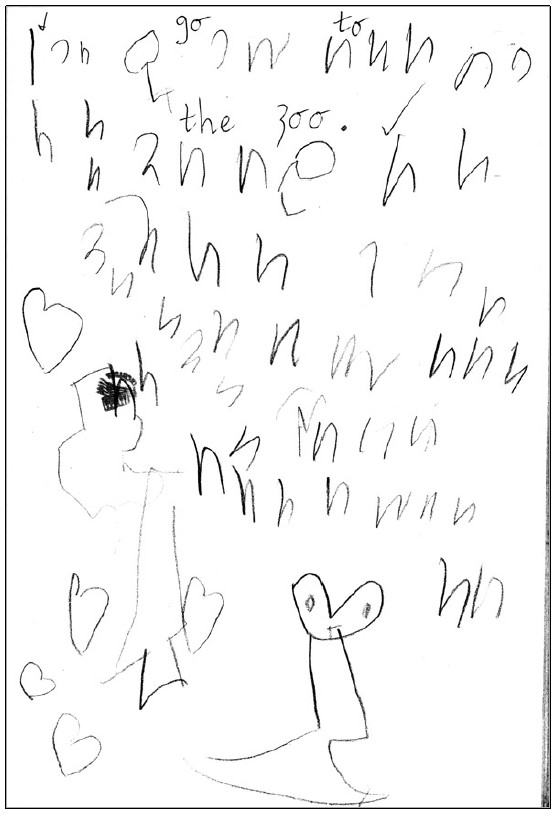
Text
I go to the zoo.
This sample of student work demonstrates that the student can:
- Write new words with an initial letter or several letters
(VCEALL077) *writes
I and the letter
g for
go
- Use some conventions for printed English
(VCEALL081) *writes left to right but not consistently
- Illustrate a simple text
(VCEALC058)
- Respond to the terms 'writing' and 'drawing' appropriately
(VCEALA059)
- Choose a topic to write or draw about
(VCEALA061)
Possible next steps for this student's learning
- Tracing letters and practising correct letter formation
(VCEALL078)
- Learning about the difference between letters, words and sentences, and spacing words
(VCEALA060)
- Copying letters, words and sentences
(VCEALL080)
Pathways and transitions considerations
A Foundation student working within the range of Level A1 in any one language mode is not ready to transition to the English curriculum regardless of their proficiency in the other two language modes. This student will continue on Pathway A of the EAL curriculum in all language modes.
Informative text - Describing leaves
Student information
The student was born in China and speaks Chinese as their home language. The student began Foundation in Victoria and is currently in a Foundation class.
Task
Students learned about the seasons. Sentence starters were written on the board as a prompt for the students to complete after a class discussion.
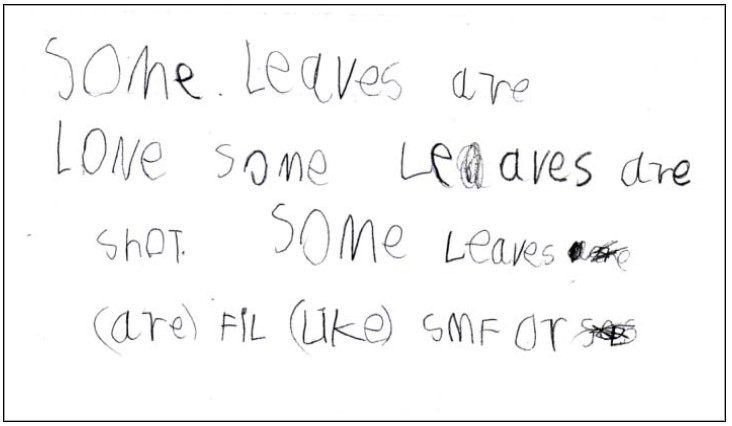
Text
Some leaves are loNe some leaves are shoT. Some leaves
are (are) fil (like) smf or
This sample of student work demonstrates that the student can:
- Copy well-known symbols, words, phrases or short texts
(VCEALC055) *copied
Some leaves
- Write new words with an initial letter or several letters
(VCEALL077) *attempted to spell
long,
short,
feel and
smooth
- Write simple repetitive modelled sentences
(VCEALL072)
- Write some high-frequency words related to personal experience and school context
(VCEALL076)
- Experiment with some familiar punctuation
(VCEALL079)
- Use some conventions for printed English
(VCEALL081)
Possible next steps for this student's learning
- Drawing and labelling pictures with common adjective-noun combinations, for example,
smooth leaves and long leaves (VCEALC058)
- Practising correct letter size and formation
(VCEALL078)
- Practising using common punctuation at the end of sentences such as full stops
(VCEALL079)
- Learning and using a range of relating verbs, for example,
be and
have
(VCEALL075)
Pathways and transitions considerations
A Foundation student working within the range of Level A1 in any one language mode is not ready to transition to the English curriculum regardless of their proficiency in the other two language modes. This student will continue on Pathway A of the EAL curriculum in all language modes.
Imaginative text – The Underwater Surprise
Student information
The student is 5 years old and in Foundation. He is from Iran and speaks Persian at home. He is currently studying in an English language school. Both parents understand some English.
Task
The teacher told the class a story using a series of pictures and gestures, which the students mimicked. Students then drew the pictures for their story on a narrative curve, and orally retold their story before writing it. Students were allowed to choose to participate in a shared writing activity with the teacher or to write their story independently, or a combination of both. This student participated in the shared writing activity. He drew the pictures on the narrative curve and used his pictures to help him retell the story to his teacher, who then scribed his words using a yellow highlighter. The student traced the sentence he dictated to the teacher and copied the sentence again underneath.
The analysis is based on the student’s writing before correction.
Note: While this is mainly a writing assessment task, the oral retell scribed by the teacher provides an indication of the student’s speaking and listening skills.
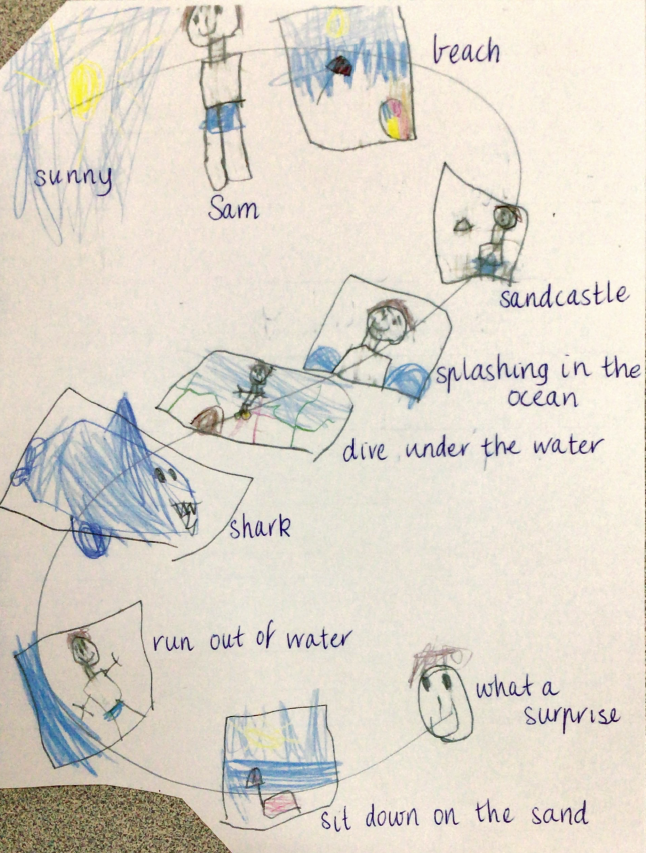
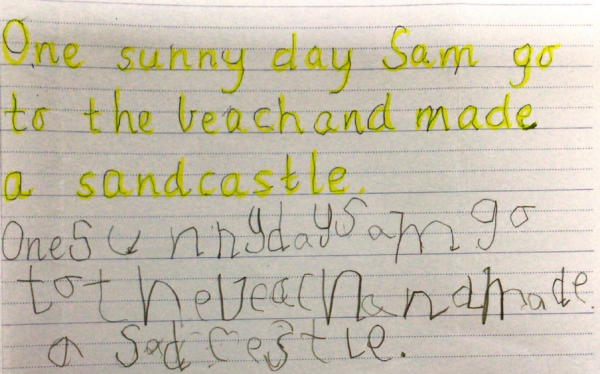
Text
Traced:
One sunny day Sam go to the beach and made a sandcastle
Copied:
SunnydaySamgo tothebeachandmadea sadcestle.
This sample of student work demonstrates that the student can:
- Respond to the terms ‘writing’ and ‘drawing’ appropriately (VCEALA059)
- Copy well-known symbols, words, phrases or short texts (VCEALC055)
- Illustrate a simple text (VCEALC058)
Transcript of oral retell:
sunny
Sam
beach
sandcastle
splashing in the ocean
dive under the water
shark
run out of water
sit down on the sand
what a surprise
This transcript of the oral retell demonstrates that the student can:
- Communicate using short, learnt phrases (VCEALL018)
- Recognise and use words from lexical sets related to immediate communicative need, interest or experience (VCEALL026)
Possible next steps for this student's learning
- Learning about letter shape, size and formation through hands-on activities, for example, making letters with play dough, writing letters in sand or on a whiteboard, writing on handwriting apps (VCEALL078)
- Practising correct letter formation and sizing using dotted-thirds lined paper ruled lines as a guide (VCEALL081)
- Improving fine motor skills required for pencil grip through activities such as threading beads, colouring, tracing, or drawing (VCEALL081)
Pathways and transitions considerations
A Foundation student working within the range of Level A1 in any one language mode is not ready to transition to the English curriculum regardless of their proficiency in the other two language modes. This student will continue on Pathway A of the EAL curriculum in all language modes.
Imaginative text – The Beach
Student information
The student is 6 years old and in Year 1. She comes from Chile and speaks Spanish as her home language. She is currently studying at an English language school. Both parents speak some English.
Task
The teacher told the class a story using a series of pictures and gestures, which the students mimicked. Students then drew the pictures for their story on a narrative curve, and orally retold their story before writing it. Students were allowed to choose to participate in a shared writing activity with the teacher or to write their story independently, or a combination of both. This student was not confident writing and chose to participate in the shared writing activity before copying the text. However, she wrote shark independently.
The analysis is based on the student’s writing before correction.
Note: While this is mainly a writing assessment task, the transcript of the oral retell provides an indication of the student’s speaking and listening skills.
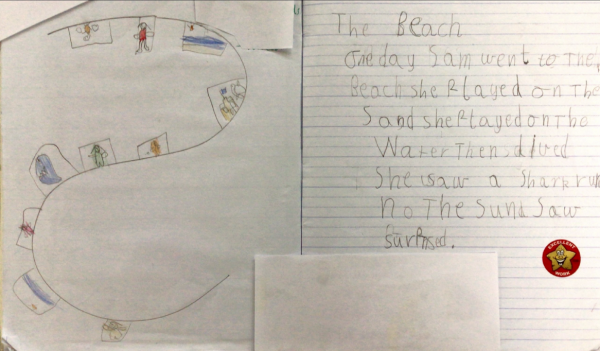
Text
The Beach
One day Sam went to The Beach she played on The Sand she played on The Water Then dived She saw a Shark run no The Sund Saw surPrised.
This sample of student work demonstrates that the student can:
- Copy well-known symbols, words, phrases or short texts(VCEALC055)
- Illustrate a simple text (VCEALC058)
- Respond to the terms ‘writing’ and ‘drawing’ appropriately (VCEALA059)
- Use some conventions for printed English (VCEALL081)
Transcript of oral retell:
One day Sam went to the beach. She play on the sand then she play on the water. She die under the water. She saw shark. She ran. She [inaudible]. She said a surprise.
Note from teacher: The student started retelling the story word by word, but her speech became more fluent as she continued.
This transcript of the oral retell demonstrates that the student can:
- Construct simple subject–verb–object sentences that mostly use present tense (VCEALL019)
- Use a small range of grammatical patterns (VCEALL020)
- Use intelligible pronunciation but with many pauses and hesitations (VCEALL028)
Possible next steps for this student's learning
- Ruling a left margin on the page to guide her to improve the placement of her writing (VCEALL070)
- Re-reading her own writing, with teacher support (VCEALA063)
- Breaking up sentences with appropriate punctuation (VCEALL079)
- Practising handwriting with a focus on letter formation and correct placement of upper and lower case letters on dotted-thirds lined paper (VCEALL078)
- Learning to identify and represent the initial, middle and final sounds in consonant-vowel-consonant (CVC) words, with teacher support (VCEALL077)
Pathways and transitions considerations
A Year 1 student working within the range of Level A1 in any one language mode is not ready to transition to the English curriculum regardless of their proficiency in the other two language modes. This student will continue on Pathway A of the EAL curriculum in all language modes.
Persuasive text – Socks I like
Student information
The student is 5 years old and in Foundation. He is from Iran and speaks Persian at home. Both parents speak and understand some English. He is currently studying in an English language school.
Task
The students have been learning about clothing. They have been learning to describe the colour and size of different items of clothing. In this task, the students read a story about a boy who went shopping and spoke about the different types of socks he liked or disliked. Each student was given a different coloured sock which they had to decide whether they liked or disliked, then explain why. The teacher modelled the sentence structure This is a _________ sock. I like __________ because _________.
The student dictated his sentences for the teacher to write on a mini whiteboard. The student copied the scribed sentences.
The analysis is based on the student’s writing before correction.
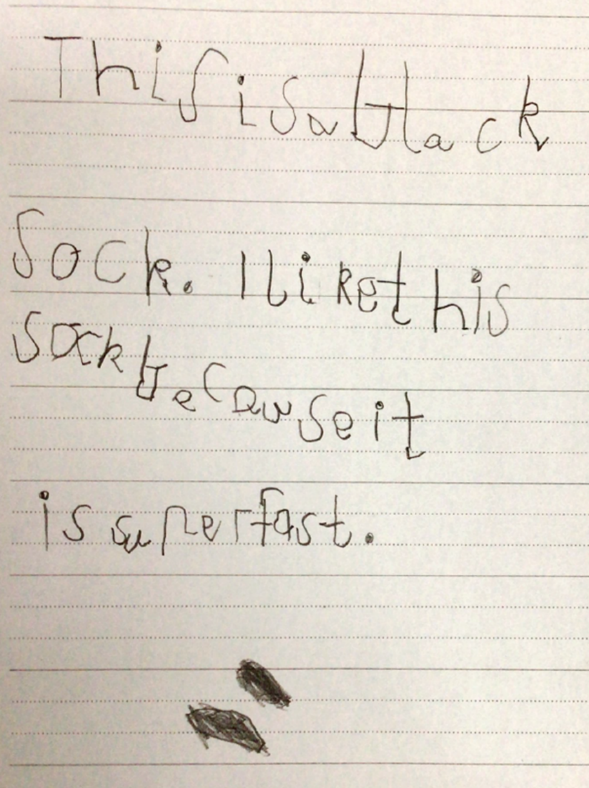
Text
This is a black Sock. I like this sock because it is superfast.
This sample of student work demonstrates that the student can:
- Copy well-known symbols, words, phrases or short texts (VCEALC055)
- Illustrate a simple text (VCEALC058)
Possible next steps for this student's learning
- Participating in a range of hands-on activities that focus on letter formation, size, spacing and placement for both upper and lower case letters (VCEALL078)
- Participating in a range of hands-on activities to learn about initial letter sounds (VCEALL077)
- Contributing ideas and words in shared writing activities, for example, when writing a class book (VCEALA062)
Pathways and transitions considerations
A Foundation student working within the range of Level A1 in any one language mode is not ready to transition to the English curriculum regardless of their proficiency in the other two language modes. This student will continue on Pathway A of the EAL curriculum in all language modes.
Related pages
Student work samples: Level A1 Speaking and Listening
Student work samples: Level A1 Reading and Viewing
Student work samples: Level A2 Writing